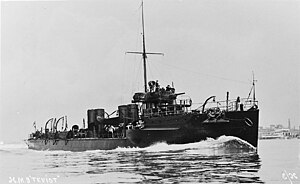HMS Ribble (1904)
 HMS Teviot, sister-ship to Ribble
| |
| History | |
|---|---|
| Name | Ribble |
| Ordered | 1901 – 1902 Naval Estimates |
| Builder | Yarrows, Poplar |
| Laid down | 4 July 1902 |
| Launched | 19 March 1904 |
| Commissioned | June 1904 |
| Out of service | 1919 |
| Honours and awards | Dardanelles 1915 - 1916 |
| Fate | Sold for breaking, 29 July 1920 |
| General characteristics [1][2] | |
| Class and type | Yarrow-type River-class destroyer |
| Displacement |
|
| Length | 231 ft 4 in (70.51 m) o/a |
| Beam | 23 ft 6 in (7.16 m) |
| Draught | 7 ft 2.5 in (2.197 m) |
| Installed power | 7,000 shp (5,200 kW) |
| Propulsion |
|
| Speed | 25.5 kn (47.2 km/h) |
| Range |
|
| Complement | 70 officers and men |
| Armament |
|
| Service record | |
| Part of: |
|
| Operations: | World War I 1914 - 1918 |
HMS Ribble was a Yarrow-type
Construction
She was laid down on 4 July 1902 at the Yarrow shipyard at Poplar and launched on 19 March 1904. Her build was completed in June 1904. Her original armament was to be the same as the turtleback torpedo boat destroyers that preceded her. In 1906 the Admiralty decided to upgrade the armament by fitting three 12-pounder 8 hundredweight (cwt) guns instead of the five 6-pounder guns. Two were mounted abeam at the foc'x'le break and the third gun was mounted on the quarterdeck.
Service history
After commissioning she was assigned to the East Coast Destroyer Flotilla of the 1st Fleet and based at Harwich.
On 27 April 1908 the Eastern Flotilla departed Harwich for live fire and night manoeuvres. During these exercises Attentive rammed and sank Gala then collided with Ribble and holed her below the waterline. She had to put into Sheerness for repairs.[3][4][5]
In 1909/1910 she was assigned to the
On 30 August 1912 the Admiralty directed that all destroyer classes were to be designated by letters. The ships of the River class were assigned to the E class and after 30 September 1913, she was known as an E-class destroyer and had the letter ‘E’ painted on the hull below the bridge area and on either the fore or aft funnel.[6]
In July 1914 she was on China Station based at Hong Kong tendered to HMS Triumph. Ribble was assigned to patrol duties under the command of the commodore at Hong Kong.[7]
With the fall of
On 17 March 1915, she closed on the French battleship Bouvet after she struck a mine in the Dardanelles.
On 25 April 1915, under the command of Lieutenant Commander R W Wilkinson, she supported the landings at ANZAC Cove.
By 10 February 1916 Ribble was on the
She remained in the Mediterranean until the end of the war.In 1919 she returned to home waters, was paid off and laid up in reserve awaiting disposal. On 29 July 1920 she was sold to Thos. W. Ward of Sheffield for breaking, appropriately given her name, on the River Ribble at Preston, Lancashire.
She was awarded the battle honour "Dardanelles 1915 - 1916" for her service
References
- ^ Jane, Fred T. (1969) [1905, Sampson Low Marston, London]. Jane’s Fighting Ships 1905/6. New York: ARCO Publishing Company. p. 75.
- ISBN 1 85170 378 0.
- ^ "Destroyer Cut In Half". Poverty Bay Herald. 12 June 1908. p. 5.
- ^ "A Naval Collision: British Destroyer Sunk". The Gympie Times. 30 April 1908. p. 3.
- ^ "Naval Matters–Past and Prospective: Sheerness Dockyard". The Marine Engineer and Naval Architect. 1 June 1908. p. 441.
- ISBN 0 85177 245 5.
- ^ a b "Naval Database".
Bibliography
- Chesneau, Roger & Kolesnik, Eugene M., eds. (1979). Conway's All The World's Fighting Ships 1860–1905. London: Conway Maritime Press. ISBN 0-85177-133-5.
- ISBN 978-1-86176-281-8.
- Dittmar, F.J.; Colledge, J. J. (1972). British Warships 1914–1919. Shepperton, UK: Ian Allan. ISBN 0-7110-0380-7.
- Friedman, Norman (2009). British Destroyers: From Earliest Days to the Second World War. Barnsley, UK: Seaforth Publishing. ISBN 978-1-84832-049-9.
- Gardiner, Robert & Gray, Randal, eds. (1985). Conway's All The World's Fighting Ships 1906–1921. London: Conway Maritime Press. ISBN 0-85177-245-5.
- Manning, T. D. (1961). The British Destroyer. London: Putnam & Co. OCLC 6470051.
- March, Edgar J. (1966). British Destroyers: A History of Development, 1892–1953; Drawn by Admiralty Permission From Official Records & Returns, Ships' Covers & Building Plans. London: Seeley Service. OCLC 164893555.
